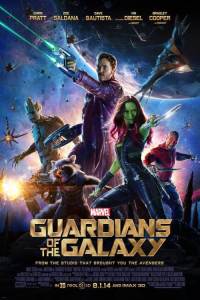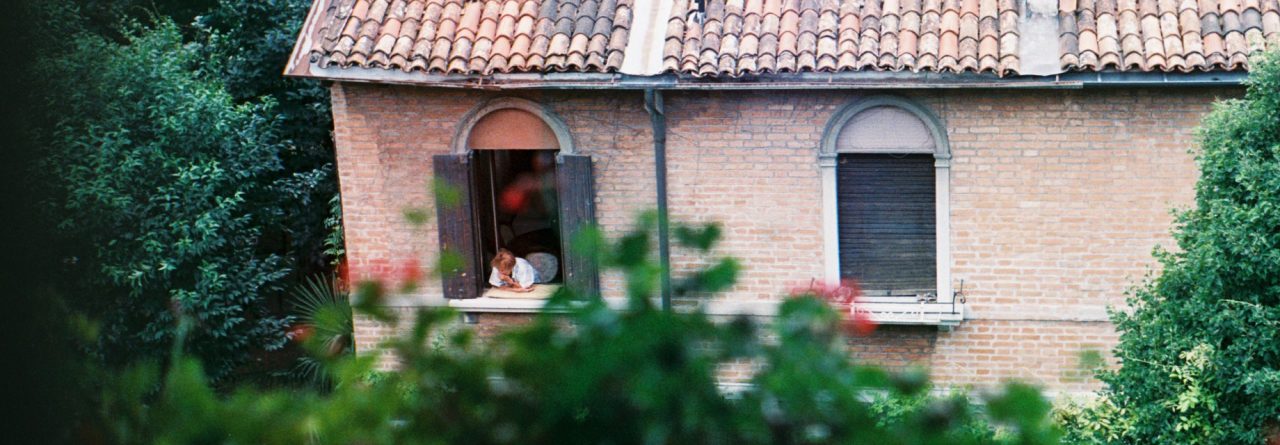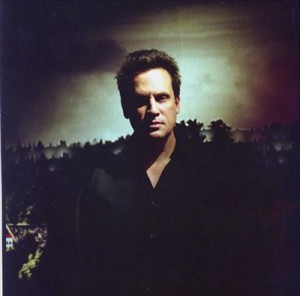 Writer-director James Gunn of the cult horror-comedy Slither (2006) and the Kick-Ass-esque dark-comedy Super (2010) maintains his edgy, irreverent tone in his transition to the Hollywood blockbuster.[i]
Writer-director James Gunn of the cult horror-comedy Slither (2006) and the Kick-Ass-esque dark-comedy Super (2010) maintains his edgy, irreverent tone in his transition to the Hollywood blockbuster.[i]
Guardians of the Galaxy (2014) follows a rag-tag gang of interplanetary outlaws as they scrape by, skirmish to skirmish.[ii] Gunn says that he took more inspiration from the stylised 2008 reboot of the comic than the original series, and diehard comic fans will notice the changes made.[iii] Though it can’t be described as witty or laugh-out-loud funny, its flippant humour playfully subverts the more grandiose aspects of its genres in a way that almost satirises itself.
The opening scene and ’70s soundtrack harken back to what Christine Cornea calls, in Science Fiction Cinema (2007) the second Golden Age of sci-fi, from the late 1970s into the ’80s.[iv] It begins on Earth, 1988, with a young Peter Quill at his mother’s hospital bedside, bathed in ghostly green light. She reaches out for him, he recoils momentarily, and she passes away before he can summon the courage to take her hand. It’s a powerful opening scene, the kind of alchemising pain and loss that every superhero backstory needs. As he runs away across a moonlit, misty field, his silhouette brings to mind the classic scene from E.T. the Extra-Terrestrial (1982) as Elliott and E.T. cycle past the moon.[v] A light hits him, and out of the fog a spaceship appears, beaming him up from Earth. The whole scene is a nod back to the ’80s, science-fiction’s second Golden Age, when a renewed interest in the 1947 Roswell incident inspired imaginings of UFOs and alien abductions.[vi] The soundtrack works incredibly well with the film: in the opening scene it creates an eerie, uncanny juxtaposition, like the child abduction scene in Close Encounters of the Third Kind (1977) when Johnny Mathis’s Chances Are plays off an old jukebox, or in the Fallout video game series which marries ’50s music and aesthetics to a future post-apocalyptic America.[vii] However, for the rest of the film the soundtrack serves to normalise and familiarise the audience to the fantastic galaxy of the Guardians. Plus, it’s a very good soundtrack.
Though classed as a superhero film, it sets itself apart from the other superhero films set in the Marvel universe, namely The Avengers (2012).[viii] In the after-credit scene of Avengers: Age of Ultron (2015), there is a hint at an Avengers-Guardians crossover, but I can’t see this working too well – the Guardians belong in their galaxy, the Avengers belong on Earth.[ix] Guardians of the Galaxy has more in common with the space opera genre; Gunn says himself, ‘[i]t’s one thousand [sic] per cent space opera.’[x] With dead planets, plenty of sword-and-sorcery style combat and a mining colony on the severed head of an ancient Celestial being, it’s dripping with the fantasy elements that help define the space opera genre.[xi] The Star Wars (1977) influence is impossible to miss, with the rakish Peter Quill (Chris Pratt) aka Star-Lord as Han Solo, leather-bound sassy assassin Gamora (Zoë Saldana) as Princess Leia, Tolkienesque tree-man Groot (Vin Diesel) as Chewy and the dark, dramatic Ronan the Accuser (Lee Pace) as Darth Vader.[xii] The Guardians are rather morally ambiguous characters, thieves, murderers, assassins. As Gunn says, ‘I also find characters with shades of grey more interesting than characters who are just black and white, good and bad.’[xiii]
But while the Guardians, and the outlaw band the Ravagers, may inhabit the ambiguous grey space, the black-and-white still exist – and I mean that in the most binary-oppositional, deconstructionist sense of the term – and this is where the film fails, spectacularly. On the one hand we have the Nova Empire, characterised by the bright, modern metropolis of Xandar, a utopian New York City, introduced for familiarity alongside Rocket Raccoon’s (Bradley Cooper) New Jersey accent and Stan Lee’s cliché cameo as he harasses some poor young woman. On the other we have the blue-skinned Kree, a dark and mysterious empire who have just signed a peace treaty with the Nova Empire, ending a thousand years of war. But the fanatic Ronan the Acuser does not recognise the treaty and plots to destroy Xandar. ‘They call me terrorist. Radical. Zealot. Because I obey the ancient laws of my people, the Kree… and punish those who do not,’ announces Ronan, in a dark and ancient temple, before brutally and ritually killing a white, Xandarian (American) Nova corpsman.[xiv] In an American post 9/11 film, the word ‘terrorist’ has clear connotations. Racial and ethnic tensions are commonly covered in science fiction, established through a binary opposition of the Self and the Other, often through alien species.[xv] Here, the Self and the Other are clearly defined as the civilised, white West against an exotic and savage East. Edward Said has written extensively on this, most notably in his book Orientalism (1978).[xvi] In an article titled ‘Islam Through Western Eyes’ (1980), Said writes of the Western fear of Islam and the crude, dehumanising caricatures of Muslims and Arabs in Western culture.[xvii] Guardians of the Galaxy presents an Orientalist view of Muslims, crude and dehumanising, depicting them as exotic, savage terrorists in the case of Ronan and his fanatic followers. The official Kree Empire refuse to act against Ronan, responding to Nova’s plea for help with cold indifference, completing Gunn’s racist portrayal of the Middle East. It’s impossible that Gunn could be ignorant to this reading of his film. Other recent films, including Hollywood blockbusters, have handled concepts of the Self and Other and of colonialism without this anti-Other ideology, such as James Cameron’s Avatar (2009), or Niell Blomkamp’s District 9 (2009) which is in fact a brilliant critique of Otherness.[xviii]
It’s unusual that a xenophobic message should come in the form of a space opera, as Nicholas Barber in ‘Out of This World’ (2014) speculates that since the decline of the space opera in the late ’90s and early noughties, after its post-Star Wars heyday, the 9/11 attack and subsequent ‘war on terror’ have made the space opera seem inappropriate as ‘no Hollywood producer wanted to suggest that it was exhilarating to zoom away to an alien domain, nor that the natives there could become your friends.’[xix] However, there is a precedent for racist undertones in space operas: Star Wars draws heavily on the Christian crusades, creating a binary opposition between the dark side of the Sith and the light, white side of the Jedi knights. The Star Wars (1999) prequel trilogy took this further with overtly racist caricatures.[xx] It’s a crying shame, as Guardians of the Galaxy was an enjoyable film, ruined by its Islamaphobic undertones. I recommend that if you watch it, do so from what Stuart Hall has termed a ‘negotiated position’: that is, be aware of the potentially insidious ideologies and reject them, but enjoy the action, awe and comedy that Guardians of the Galaxy has to offer.[xxi]
To end on a high note, the success of Guardians of the Galaxy could signify a return of the fantastic space opera genre. With the upcoming release of the new Star Wars trilogy, directed by JJ Abrams, including Star Wars spin-offs now in preproduction, and rumours of a new Netflix Star Trek series, the genre could be making a comeback.[xxii] The huge popularity of the television series Game of Thrones (2011) is also a factor, as the space opera and fantasy genres have much in common, as Gunn says himself, ‘we have more in common with Game of Thrones as we do with 2001.’[xxiii] As Damien Walter writes in ‘Space Opera Strikes Up Again for a New Era’ (2014), ‘[a]fter years condemned to the outer darkness of secondhand bookshops, Space Opera is once again exciting the imagination of sci-fi fans.’[xxiv] Guardians of the Galaxy may be at the forefront for a new era of space opera – let’s hope they get it right next time.
[i] Slither. Dir. James Gunn. Universal Pictures. 2006; Super. Dir. James Gunn. IFC Films. 2012.
[ii] Guardians of the Galaxy. Dir. James Gunn. Marvel Studios. 2014.
[iii] Guardians of the Galaxy, Marvel Comics, 2008; James Gunn, The Badass Interview: James Gunn on Guardians of the Galaxy, Devin Faraci, http://birthmoviesdeath.com/2014/07/29/the-badass-interview-james-gunn-on-guardians-of-the-galaxy, [accessed 19 May 2015]
[iv] Christine Cornea, Science Fiction Cinema: Between Fantasy and Reality, (Edinburgh University Press, 2007), [on-line] available at https://www.dawsonera.com/readonline/9780748628704 [accessed 19 May 2015], p. 82.
[v] E.T. the Extra-Terrestrial. Dir. Steven Spielberg. Universal Pictures. 1982.
[vi] Kal A. Korf, ‘What Really Happened at Roswell’, in Skeptical Inquirer, (1997), http://www.csicop.org/si/show/what_really_happened_at_roswell [accessed 19 May 2015]
[vii] Close Encounters of the Third Kind. Dir. Steven Spielberg. Columbia Picture. 1977; Robert Allen and Al Stillman. Chances Are. Johnny Mathis. 1957; Fallout 3. Bethesda Softworks. 2008.
[viii] The Avengers. Dir. Joss Whedon. Marvel Studios. 2012.
[ix] Avengers: Age of Ultron. Dir. Joss Whedon. Marvel Studios. 2015.
[x] Gunn, The Badass Interview
[xi] Nicholas Barber, ‘Out of this world: are space operas making a comeback?’, The Guardian, June 2014, http://www.theguardian.com/film/2014/jun/12/are-space-operas-making-comeback-guardians-of-the-galaxy [accessed 19 May 2015]
[xii] Star Wars. Dir. George Lucas. 20th Century Fox. 1977.
[xiii] Gunn, The Badass Interview
[xiv] Guardians of the Galaxy. Gunn.
[xv] Cornea, p. 176, p. 179.
[xvi] Edward Said, Orientalism, (New York: Pantheon, 1978)
[xvii] Edward Said, ‘Islam Through Western Eyes’, in The Nation, April 1980, [on-line] available at http://www.thenation.com/article/islam-through-western-eyes [accessed 19 May 2015]
[xviii] Avatar. Dir. James Cameron. 20th Century Fox. 2009; District 9. Dir. Niell Blomkamp. TriStar Pictures. 2009.
[xix] Barber.
[xx] Star Wars: The Phantom Menace. Dir. George Lucas. 20th Century Fox. 1999.
[xxi] Stuart Hall, ‘Encoding, Decoding’, in The Cultural Studies Reader, ed. by Simon During, (London: Routledge, 1993) pp.507-517, (p. 515).
[xxii] Barber; Jessica Toomer, ‘A New ‘Star Trek’ Series Might Be In the Works at Netflix’, The Huffington Post, 2014, http://www.huffingtonpost.com/2014/06/20/star-trek-reboot-netflix_n_5516042.html [accessed 19 May 2015]
[xxiii] Game of Thrones. David Benioff and D.B. Weiss. HBO. 2011; Gunn, The Badass Interview
[xxiv] Damien Walter, ‘Space Opera strikes up again for a new era’, The Guardian, August 2014, http://www.theguardian.com/books/booksblog/2014/aug/29/space-opera-new-guardians-of-the-galaxy-ancillary-justice [accessed 19 May 2015]




 Mark Kozelek muttered and mumbled about how bright it was in St. George’s Church, looking out at five hundred fully visible faces. The sun had not yet set and soft evening light poured in through the round-headed windows suffusing the church with feathery shadows and illuminating the audience.
Mark Kozelek muttered and mumbled about how bright it was in St. George’s Church, looking out at five hundred fully visible faces. The sun had not yet set and soft evening light poured in through the round-headed windows suffusing the church with feathery shadows and illuminating the audience. Writer-director James Gunn of the cult horror-comedy Slither (2006) and the Kick-Ass-esque dark-comedy Super (2010) maintains his edgy, irreverent tone in his transition to the Hollywood blockbuster.
Writer-director James Gunn of the cult horror-comedy Slither (2006) and the Kick-Ass-esque dark-comedy Super (2010) maintains his edgy, irreverent tone in his transition to the Hollywood blockbuster.